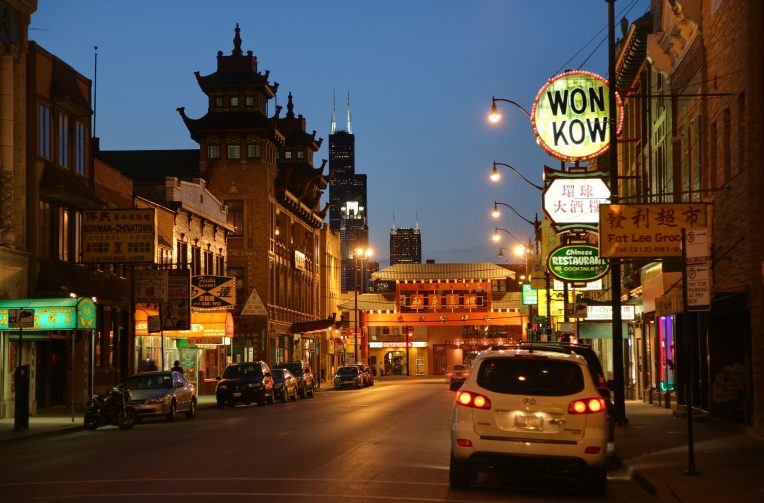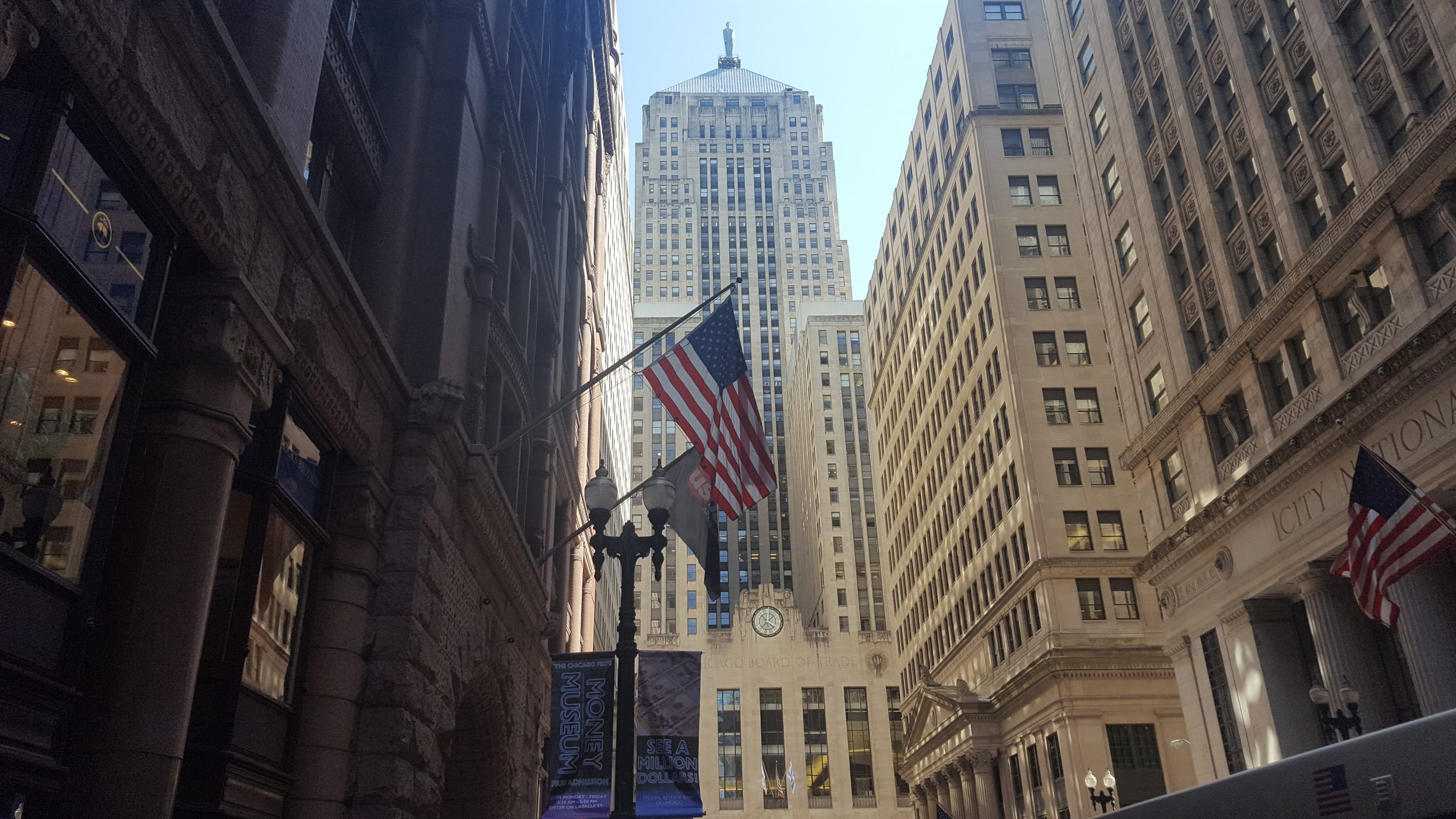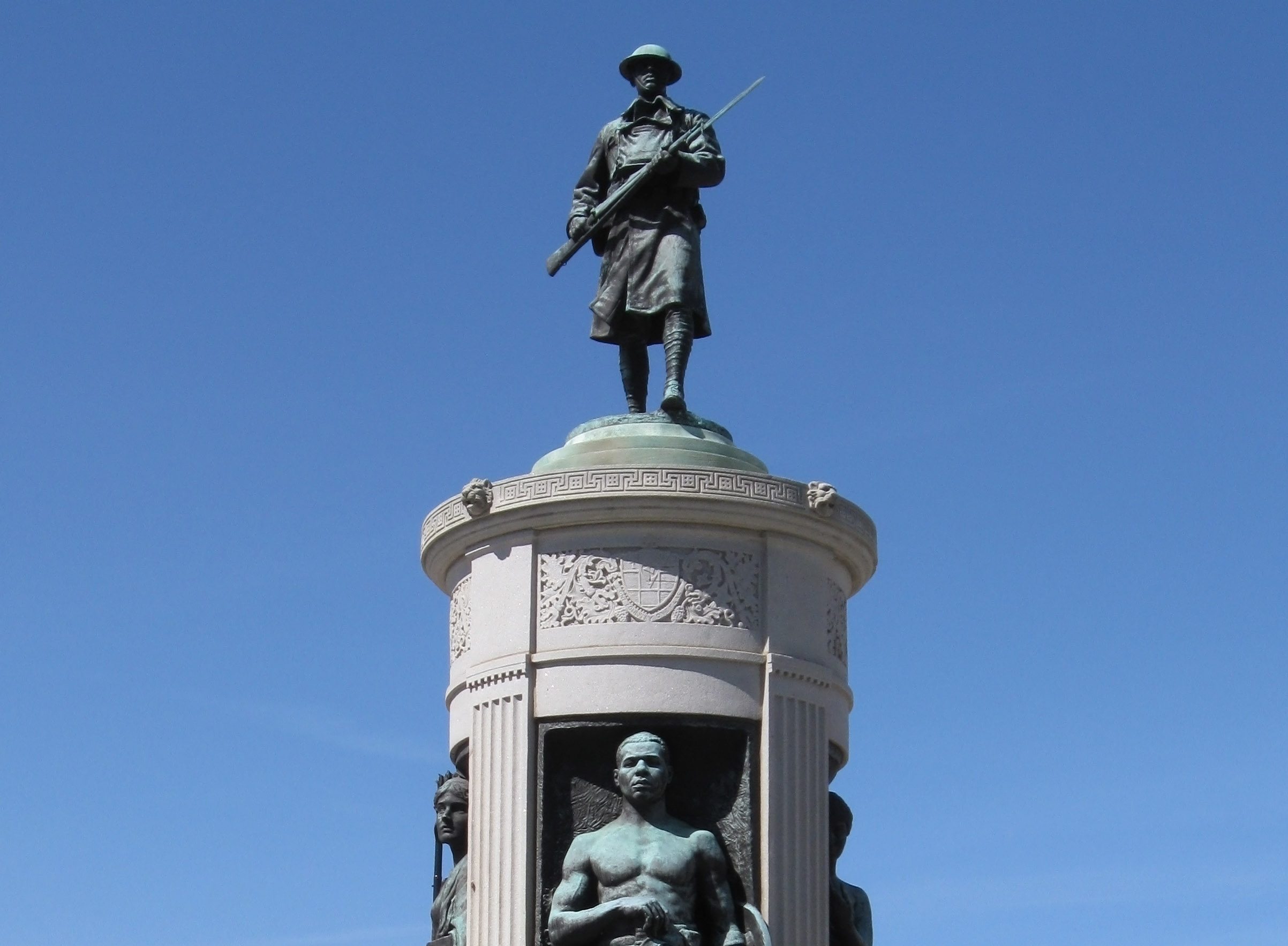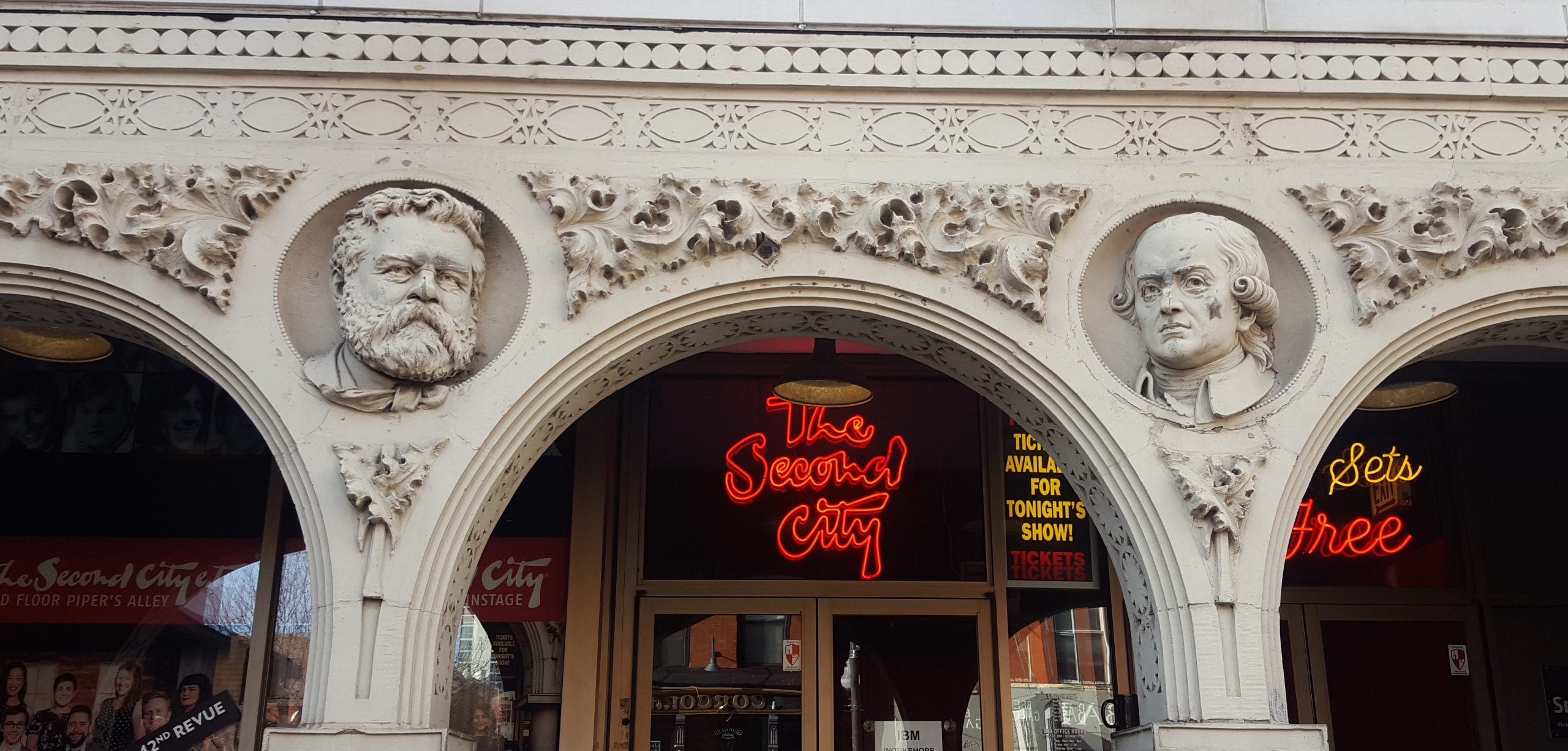Chicago’s Chinatown is one of the city’s densest and busiest neighborhoods. Located on the South Side, it’s the beating heart of Chicago’s Chinese community. But it’s not the first such Chinese neighborhood in the city. The original and now-forgotten Chinatown is right on the southern edge of the Loop, hidden behind the financial district. Sadly, only tiny remnants of this vanished neighborhood still exist. With some research I uncovered some of the neighborhood’s fascinating and turbulent history.
We research Chicago history and architecture like this while developing our live virtual events and custom corporate events. Join us for our public virtual events or book an exclusive team-building event for your private group. We can also create custom tours and original content creation about this Chicago topic and countless others.
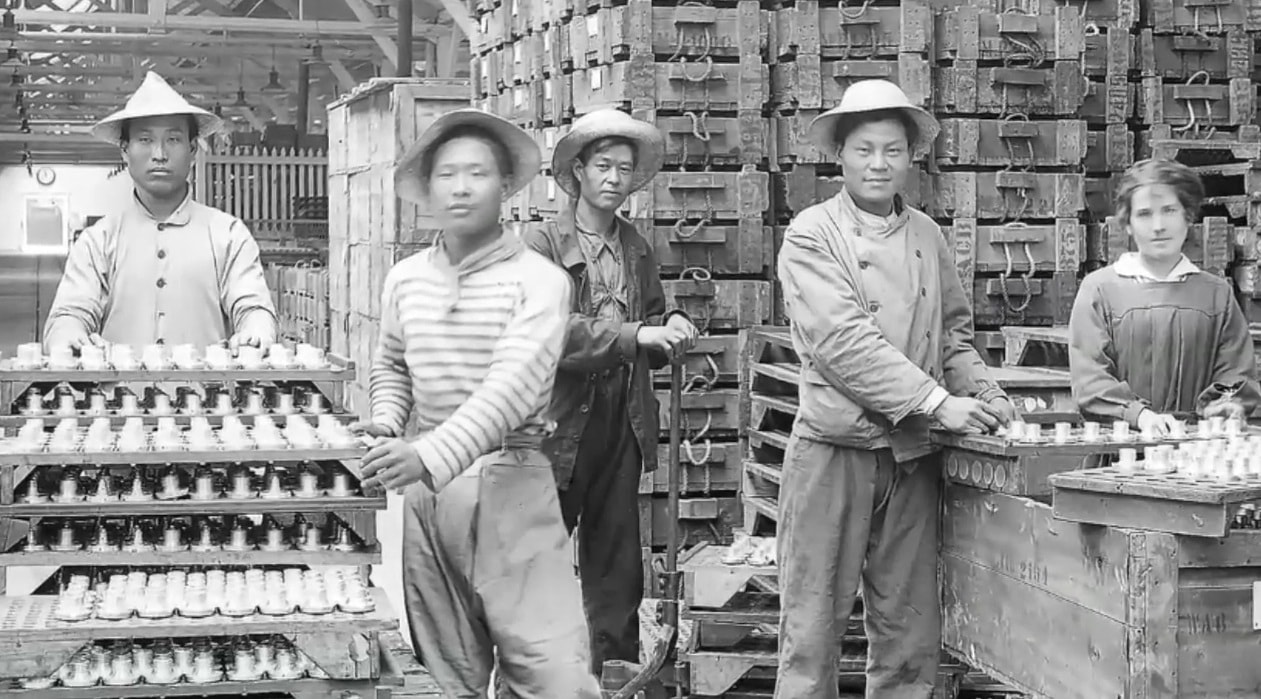
Chinese Settlement in Chicago
The forgotten Chinatown near the Loop is, according to Wikipedia, the second-oldest Chinese community in the United States. (Color me a bit skeptical here.) Chinese immigrants first came to the United States in large numbers in the mid-to-late 1800’s. They emigrated to the Western US to work in the California Gold Rush. Later, they helped build the transcontinental railroads. Chicago, of course, is the focal point of the American railway system. Chinese laborers arrived here not long after the famous golden spike completed the transcontinental railroad.
Chicago may have been a refuge for many of these early Chinese immigrants. They faced virulent racism in the West. States like California created legal and social barriers which made Chinese-Americans into despised non-citizens. Chicago may have been a bit better, but our racial history is not exactly sanguine. Openly racist federal laws also discriminated against Chinese-Americans and immigrants for decades. However, even then Chicago was a city of immigrants and opportunities. So the Chinese were able to carve out an existence and form a community here.

Downtown’s Forgotten Chinatown
The forgotten Chinatown where they first settled was located on the two-block stretch of Clark Street from Van Buren to Harrison. This location had both advantages and disadvantages. Beneficially, it was smack dab in between several of the massive train stations that used to mark the southern boundary of downtown. Grand Central Station, LaSalle Street Station, and the Dearborn Station were all a stone’s throw away. The influx of people in transit created tons of business opportunities for the residents of Chinatown. According to an 1889 Tribune article, this forgotten Chinatown boasted “eight grocery stores, two drug stores, two butcher shops, two barber shops, a cigar factory and a restaurant.”
The downside was that Chinatown was directly adjacent to Little Cheyenne, a seedy neighborhood known for its criminality. According to Chicago by Day and Night, which was published for visitors to the 1893 World’s Fair, “[i]n this district reside more dangerous characters than there are in any other portion of the city.” This statement sounds like an exaggeration, and the remainder of the description of Little Cheyenne is appallingly racist.
Minority neighborhoods, like Little Cheyenne and the forgotten Chinatown, often played unwilling host to vice and crime. Upper crust WASPs and immigrant “ethnic” white didn’t want gambling or prostitution on their block. So those criminal enterprises where made to operate in minority neighborhoods whose residents didn’t have the political means to resist. The Women’s Christian Temperance Union even set up shop a couple blocks south of this block. The WCTU, of course, was a big force behind making Prohibition happen. An 1891 journal says, “Here the work goes on all night, and why not? The dives and saloons on all sides never close.”
What Remains of Little Cheyenne
The “Men Only” hotel next to the pawn shop is an interesting relic of the neighborhood’s transient history. This hotel today is one of the last remaining “cubicle hotels” in Chicago. People stay in a small room – at most 6-by-10 feet – with chicken wire ceilings separating them. Bathrooms are shared, as is a communal space with television. Historically day laborers stayed in these minimal confines for temporary jobs downtown. Today it’s the Ewing Annex Hotel, and many of the residents are on disability and stay longterm for low-income housing.
At the corner of Van Buren and Clark, the Bock Building, built in 1897, is only two stories though it was originally intended to have gone to 12. The building’s owner Johnny, is a small businessman who controls much of the corner’s real estate and owns a lovably dive-y pizzeria. He leases offices on the second floor to small businesses owners and non-profits.
I had a chat with Johnny about the neighborhood in his cramped, old-school upstairs office. He took over the restaurant that his parents started over 50 years ago. On top of owning the Bock Building, he has the adjoining one at Clark and Van Buren, which has likely the only exterior physical relic left from the old Chinatown (pictured below). The current tenant, a Mexican restaurant called La Cocina, has a sign designed to look like a Chinese pagoda. The incongruity of that sign has always caught my eye and piqued my curiosity.
Chinatown Moves South
The Chinese community moved south to its current home in the early 20th century. A confluence of factors swirled together and compelled the creation of the current Chinatown. Unfortunately, the biggest factor was likely racism. Asians were considered an unclean and distasteful population who could never integrate into American (read: white) society. Chinatown was right amidst the train stations that visitors arrived in and that lead to civic leaders thinking Chinatown gave the city a bad image. So when City Hall and business leaders started pricing them out of downtown, the Chinese community had little chance of pushing back. You can visit the contemporary Chinatown on our custom private tours of Chicago’s neighborhoods.
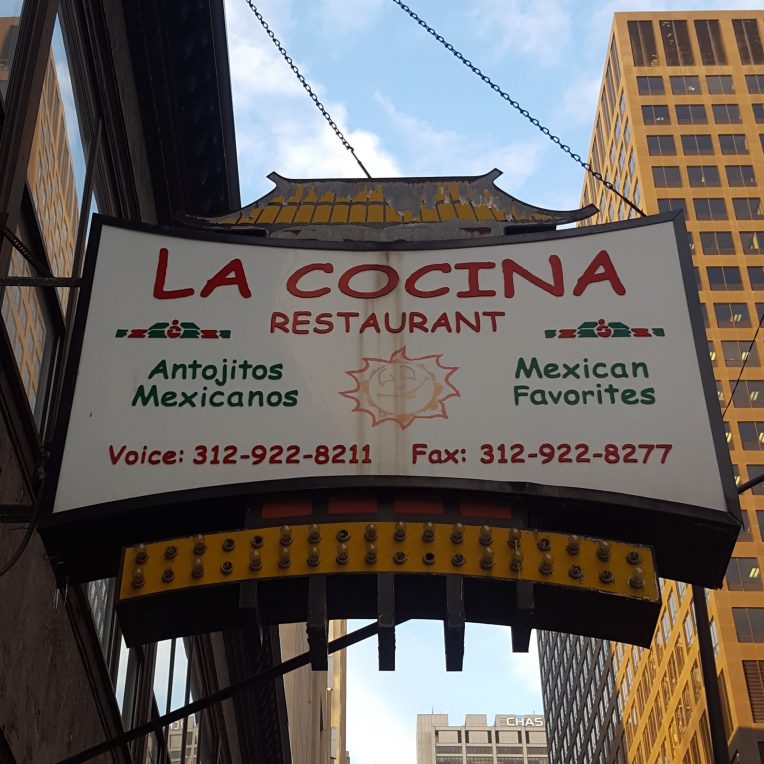
Today and Tomorrow
Almost nothing remains of the original, forgotten Chinatown in Chicago. The blocks on Clark Street were lumped into the rough and tumble Little Cheyenne neighborhood when the Chinese inhabitants moved south. The area kept that seedy vibe for decades. Later, in the 1970’s the federal government constructed the Metropolitan Correctional Facility on Clark. That lead to the demolition of many of the historic buildings that the original Chinese inhabitants of Chicago knew. Even today, the block feels like the last slice of the old skid row that used to surround the Loop. Looking at the ramshackle, century-old buildings while the Board of Trade and Willis Tower loom blocks away lends the whole area a strange, out-of-time vibe.
Johnny told me that even just a generation ago, the Chinese had more presence here. The pagoda sign is a relic from the previous tenant, the Shanghai Restaurant. The last owner of the restaurant, according to Johnny, was a Chinese-American businessman named Howie Dong. From a guidebook from the 1970s, it was a “plain and somewhat grubby spot.” They had three different menus: Cantonese, Filipino and Thai. Johnny knew another restaurant owner in the neighborhood as “Louis the Chinaman.” When his place was torn down to build the jail, this Louis opened another restaurant on the second floor of 177 N. State. I vaguely recall hearing about that restaurant, but it closed a while ago. Johnny said that to his knowledge, nothing else from the forgotten Chinatown really remains.
– Alex Bean, Content Manager and Tour Guide
ABOUT CHICAGO DETOURS
In business since 2010, Chicago Detours is a passionate team of educators, historians and storytellers. We applied a decade of experience as one of Chicago’s top-rated tour companies to become a virtual event company in 2020. We bring curious people to explore, learn and interact about Chicago’s history, architecture and culture through custom tours, content production, and virtual events.
